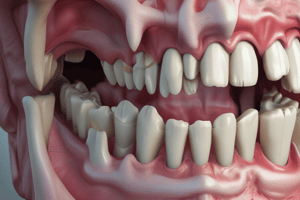Podcast
Questions and Answers
What is the most common presenting symptom of molar pregnancy?
What is the most common presenting symptom of molar pregnancy?
- Abdominal distension due to theca lutein cysts
- Hyperthyroidism
- Vaginal bleeding (correct)
- Excessive uterine enlargement
How has the mean gestation at presentation for molar pregnancy changed from 1965-1975 to 1988-1993?
How has the mean gestation at presentation for molar pregnancy changed from 1965-1975 to 1988-1993?
- Remained the same at 16 weeks
- Increased from 16 weeks to 20 weeks
- Decreased from 20 weeks to 16 weeks
- Decreased from 16 weeks to 12 weeks (correct)
Which of the following is NOT a less common presentation of molar pregnancy?
Which of the following is NOT a less common presentation of molar pregnancy?
- Early-onset pre-eclampsia
- Haemoptysis
- Vaginal bleeding (correct)
- Seizures due to metastatic disease
What trend was observed in the percentage of women presenting with only an abnormal ultrasound result between 1996 and 2006?
What trend was observed in the percentage of women presenting with only an abnormal ultrasound result between 1996 and 2006?
What condition can result from theca lutein cysts in the context of molar pregnancy?
What condition can result from theca lutein cysts in the context of molar pregnancy?
What is a less common presentation of molar pregnancies?
What is a less common presentation of molar pregnancies?
What is the definitive method for diagnosing a molar pregnancy?
What is the definitive method for diagnosing a molar pregnancy?
What is the preferred method for the removal of a complete molar pregnancy?
What is the preferred method for the removal of a complete molar pregnancy?
When is medical removal indicated for partial molar pregnancies?
When is medical removal indicated for partial molar pregnancies?
Which of the following is NOT a recognized less common presentation of molar pregnancies?
Which of the following is NOT a recognized less common presentation of molar pregnancies?
What may be used during suction curettage to minimize complications?
What may be used during suction curettage to minimize complications?
Which complication can occur due to metastatic disease in relation to molar pregnancies?
Which complication can occur due to metastatic disease in relation to molar pregnancies?
What condition is characterized by abdominal distension due to theca lutein cysts in the context of molar pregnancies?
What condition is characterized by abdominal distension due to theca lutein cysts in the context of molar pregnancies?
What is the incidence of GTD in women from Asia compared to non-Asian women?
What is the incidence of GTD in women from Asia compared to non-Asian women?
At what ages is the incidence of GTD the highest?
At what ages is the incidence of GTD the highest?
What is the estimated incidence of GTN after a live birth?
What is the estimated incidence of GTN after a live birth?
How often might a consultant obstetrician deal with a new case of GTD?
How often might a consultant obstetrician deal with a new case of GTD?
What is the cure rate of the effective registration and treatment program for GTN?
What is the cure rate of the effective registration and treatment program for GTN?
What percentage of chemotherapy cases occur after a partial molar pregnancy?
What percentage of chemotherapy cases occur after a partial molar pregnancy?
Which statement about ongoing management from GTD centers is accurate?
Which statement about ongoing management from GTD centers is accurate?
What databases were searched to develop the guidelines for GTD?
What databases were searched to develop the guidelines for GTD?
What is the follow-up procedure if hCG has not reverted to normal within 56 days after a complete molar pregnancy?
What is the follow-up procedure if hCG has not reverted to normal within 56 days after a complete molar pregnancy?
Which group of women is no longer required to have hCG measured after subsequent pregnancy events?
Which group of women is no longer required to have hCG measured after subsequent pregnancy events?
What is the primary treatment for women with GTN?
What is the primary treatment for women with GTN?
What does the FIGO 2000 scoring system reflect?
What does the FIGO 2000 scoring system reflect?
Which statement is true regarding PSTT and ETT?
Which statement is true regarding PSTT and ETT?
What is the concluding criterion for follow-up in partial molar pregnancy?
What is the concluding criterion for follow-up in partial molar pregnancy?
What is the incidence rate of GTD in subsequent pregnancies for women who have not received prior chemotherapy for molar pregnancies?
What is the incidence rate of GTD in subsequent pregnancies for women who have not received prior chemotherapy for molar pregnancies?
Which treatment regimen is given to women with a FIGO score of 6 or less?
Which treatment regimen is given to women with a FIGO score of 6 or less?
What percentage of molar pregnancies are identified correctly before 14 weeks of gestation?
What percentage of molar pregnancies are identified correctly before 14 weeks of gestation?
What is a common ultrasound feature of a complete molar pregnancy after 8 weeks of gestation?
What is a common ultrasound feature of a complete molar pregnancy after 8 weeks of gestation?
What is the positive predictive value for a partial molar pregnancy?
What is the positive predictive value for a partial molar pregnancy?
Which condition is associated with ultrasound findings of delayed miscarriage or anembryonic pregnancy?
Which condition is associated with ultrasound findings of delayed miscarriage or anembryonic pregnancy?
What ultrasound feature suggests a partial molar pregnancy?
What ultrasound feature suggests a partial molar pregnancy?
What is the reasonable sensitivity for diagnosing a complete mole via ultrasound?
What is the reasonable sensitivity for diagnosing a complete mole via ultrasound?
What is the reported incidence of unrecognized molar pregnancies after surgical removal of pregnancy tissue?
What is the reported incidence of unrecognized molar pregnancies after surgical removal of pregnancy tissue?
What suggests an increased diagnosis rate of molar pregnancies with advancing gestational age beyond 14 weeks?
What suggests an increased diagnosis rate of molar pregnancies with advancing gestational age beyond 14 weeks?
Flashcards are hidden until you start studying
Study Notes
Molar Pregnancy Presentations
- Less common symptoms include hyperemesis, excessive uterine enlargement, hyperthyroidism, early-onset pre-eclampsia, and abdominal distension from theca lutein cysts.
- Rarely, women may experience haemoptysis or seizures indicating metastatic disease affecting lungs or brain.
- Vaginal bleeding, the most prevalent symptom, occurs in 60% of presentations.
Diagnosis of Molar Pregnancy
- Definitive diagnosis is established through histological examination.
- Ultrasound plays a crucial role in early diagnosis, with a reduction in mean gestation at presentation over the decades.
Treatment for Molar Pregnancy
- Suction curettage is the preferred method for removing complete molar pregnancies.
- Ultrasound guidance may reduce perforation risk and improve tissue removal during curettage.
- Medical removal is an alternative for partial molar pregnancies when fetal parts are too large for suction curettage.
Incidence and Ethnic Variations
- Higher incidence of gestational trophoblastic disease (GTD) in women from Asia compared to non-Asian women, at rates of 1 in 387 versus 1 in 752 live births respectively.
- GTD incidence is higher in the extremes of age: 1 in 500 pregnancies for women under 15 and 1 in 8 for those over 50.
- There may be underreporting of partial moles impacting true incidence rates.
Follow-up and Management
- A structured registration and treatment program in the UK results in a cure rate of 98–100% for GTN.
- Follow-up post-complete molar pregnancy varies based on hCG normalization: if achieved in 56 days, follow-up is for 6 months; if not, 6 months after normalization.
- For partial molar pregnancy, follow-up ends after two normal hCG samples taken at least 4 weeks apart.
Treatment for Gestational Trophoblastic Neoplasia (GTN)
- GTN can be treated with single-agent or multi-agent chemotherapy based on the FIGO 2000 scoring system.
- PSTT and ETT, rare variants of GTN, are primarily treated surgically due to lower chemotherapy sensitivity.
- Women with a FIGO score of 6 or lower are treated with single-agent intramuscular methotrexate along with folinic acid.
Studying That Suits You
Use AI to generate personalized quizzes and flashcards to suit your learning preferences.




